|
GETAC S410
Intel Skylake powered semi-rugged 14-inch laptop slimmer, lighter, more versatile
(by Conrad H. Blickenstorfer -- photography by Carol Cotton)
On April 12, Getac announced the S410 notebook computer. The S410 represents the next generation of the company's popular series of S400 "semi-rugged" laptops. Getac's goal with this new machine is to enhance the functionality of the unit while minimizing bulk and weight. In terms of target markets, the S410 is a full-size, full-featured laptop specifically designed for use in a variety of field applications that require more toughness and durability than consumer products can provide, but not the higher weight and cost of fully rugged construction. Anticipated deployments for the Getac S410 includes field service, public safety, manufacturing, as well as military applications, professional services, and vehicle use. RuggedPCReview.com had a chance to have advance hands-on with the new Getac S410, and this review describes the machine, its features, and where it fits in.
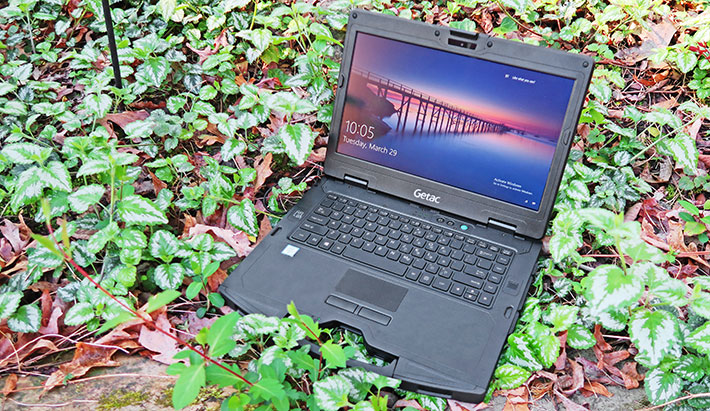
Getac S410 positioning
Right upfront, the Getac S410 is not just a tech refresh of the existing S400. It is an entirely new design, one that will be offered alongside the current S400, and eventually replace it. While it's addressing the same target markets, it is a thinner, lighter and altogether more contemporary solution. In fact, the S410 is so different from the S400 that one wonders why Getac didn't just call it the S500 or something else that more clearly differentiates it from the older model.
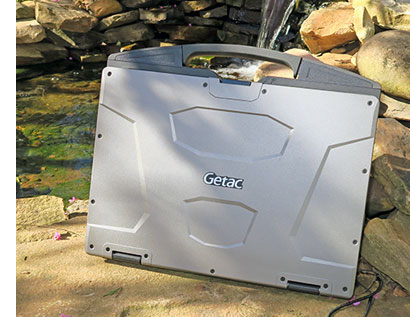 Now a word about the term "semi-rugged." It's a somewhat awkward term and it isn't clearly defined, but a better term just hasn't come along. Semi-rugged, in essence, describes a device that's more durable than your average consumer and even corporate notebook computer, but without going to extremes. Now a word about the term "semi-rugged." It's a somewhat awkward term and it isn't clearly defined, but a better term just hasn't come along. Semi-rugged, in essence, describes a device that's more durable than your average consumer and even corporate notebook computer, but without going to extremes.
Semi-rugged notebooks are for those whose laptops spend more time outdoors and on the road than on desks. Semi-ruggeds must be spill-proof, able to handle vibration, be viewable and usable at night as well as in bright sunshine. They must be fast and powerful, but also have great battery life, plenty of connectivity, and be handy enough to take anywhere. And, oh, they shouldn't cost a lot. At least not nearly as much as a fully-rugged laptop. That's quite a challenge.
Getac set itself the additional task of designing a computer that would clearly surpass its own and quite successful S400. They came up with a new design that's 27% thinner and 23% lighter, which is huge when you use a computer on the road. The S410 measures 13.8 x 11.5 inches, is just 1.4 inches thick, and, similarly equipped, weighs a pound less than the old S400. The S410 has a 14-inch LCD display — large enough for any work — and it can be ordered with either 1366 x 768 or higher 1920 x 1080 pixel resolution, both with capacitive multi-touch.
|
Getac semi-rugged notebooks
|
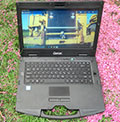
|
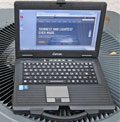
|
|
Model
|
Getac S410
|
Getac S400
|
|
Introduced
|
2016
|
2014 version
|
|
Size (inches)
|
13.8 x 11.5 x 1.4
|
13.7 x 10.15 x 1.93
|
|
Weight
|
5.9 lbs as tested
|
7.5 lbs. as tested
|
|
Intel Processor
|
Skylake (6th gen)
|
Haswell (4th gen)
|
|
Thermal Design Power (TDP)
|
15 watts
|
37 watts
|
|
Display size (inches)
|
14.0 (1920x1080)
|
14.0 (1920x1080)
|
|
Touchscreen
|
Capacitive multi-touch
|
Resistive multi-touch opt.
|
|
Battery capacity
|
2 x 46.6 watt-hours
|
94 watt-hours
|
|
Battery life
|
20+ hrs.
|
up to 11 hrs.
|
|
Drop spec
|
3 feet
|
3 feet
|
|
Ingress Protection
|
IP51
|
IP5X
|
|
Starting price
|
US$1,399
|
US$1,599
|
The picture above to the right says more than the proverbial thousand words. No consumer notebook looks like this. The S410 is clearly built tough enough to be used outdoors and on the job. There's an integrated handle to carry the device without the need to bring along a bag for it. All of the ports have protective covers because it can get dusty and wet out there. And everything is built tough to absorb the occasional bump or drop. If the S410 were a vehicle it'd be an offroad-capable 4-wheel-drive SUV, more able to take a beating out there, but not as extreme (or expensive) as a dedicated military vehicle.
A full-size semi-rugged notebook is also expected to have enough performance to run any application well, a display bright enough to be used out in the sun, cover all the bases in wireless communication, have enough onboard connectivity to hook up to almost anything, and there must also be a full-size keyboard to make typing bearable in the field. The Getac S410 delivers in all these areas.
In terms of competition, the Getac S410 is squarely aimed at Panasonic's Toughbook 54, Dell's Latitude 14 Rugged, and GammaTech's Durabooks. There are also several Taiwan-based OEMs that sell durable and semi-ruggeds under various brand names and sometimes also their own. For customers seeking a semi-rugged from one of the major rugged computing vendors, the Getac S410 will definitely be on the short list.
Design and construction
The Getac S400 was and is an attractive laptop, but the new S410 has it beat. It retains Getac's trademark matte black and gun-metal gray color scheme, but the new model with its contoured top looks noticeably more sculpted and, well, tougher. Whereas the S400 was quietly elegant, the S410 signals toughness and that it's ready to go to work. Its industrial design at its best, with mechanical details — contours, exposed screws, reinforcements, etc. — suggesting industrial-grade machinery without overdoing it. It's one of the best-looking ruggedized laptops we've seen in a long time. All that said, the S410 remains a semi-rugged design. So unlike Getac's fully rugged models, the S410's case is made of what Getac calls "KryptoShell" ABS+PC polymer plastic material, and not magnesium-alloy. You can hardly tell, though; the S410 looks and feels as tough and solid as the magnesium-clad fully rugged Getacs. Below you can see the unit from the top and all four sides:
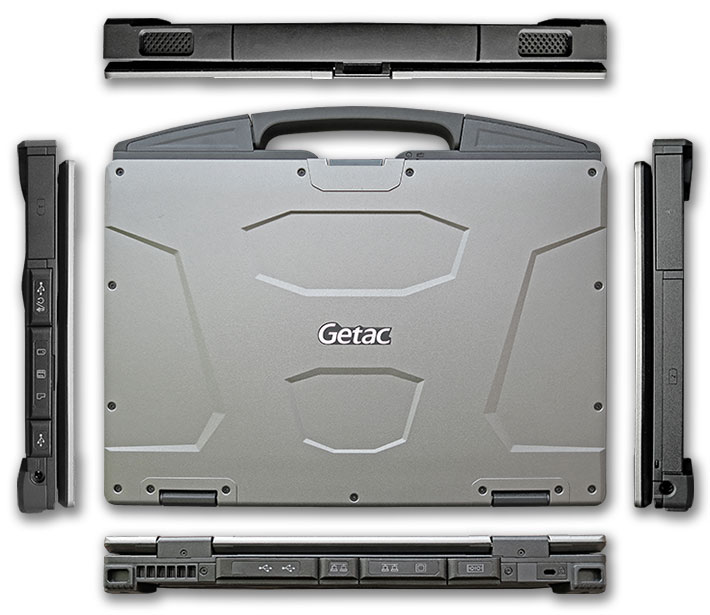
With the rugged good looks of the S410 it's easy to forget, however, that this is a semi-rugged machine that is not designed to be waterproof. Getac calls it "water resistant," which in this context means it can handle a spill onto its keyboard and a bit of rain. And there are protective doors that keep liquids away from ports. But the S410 is not a sealed machine. There are air vents and other openings to the inside through which liquids can get in. There is a small improvement compared to the S400: whereas that machine did not carry an IP rating for liquids, the S410 is IP51 rated. That means it's protected against vertically falling drops of water (or coffee or soda).
Laptops often have removable covers on the bottom, to provide access to memory and other expansion slots. The S400 had them, but the S410 doesn't. This means that the entire bottom half of the S410 needs to be removed to get to the laptop's RAM or M.2 slots. That's not as convenient as having the access doors as it takes longer to take the entire bottom off. It's not a big deal, though, as most laptops will be ordered with whatever options are needed for the job. And for the paranoid: it's takes longer for a thief to take the machine apart to steal components than to just open an expansion port.
Opening up the S410 is easy, but it involves undoing a lot of little screws, almost 40 in total. Nice design detail here: Getac is using two types of screws, most of them short, but some long. Screw holes where the long screws go are clearly marked. This way getting all the screws back into their proper place isn't trial-and-error.
Once all the screws are undone, the housing comes apart easily. There aren't any clips that might break off, and since this isn't a sealed design, there also isn't a perimeter seal to worry about. And there aren't any wires or ribbons between the two parts of the S410's CPU case. Service technicians appreciate that. And this is what it looks inside:
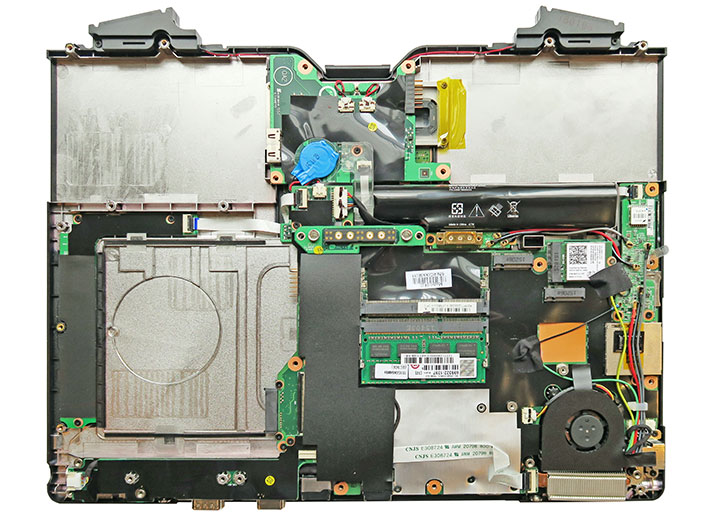
Compared to the older S400, the S410's motherboard and electronics have shrunk considerably. The motherboard, which occupies part of the space underneath the keyboard, is a full third smaller. Like in the S400, there does not appear to be a metal frame or chassis; instead, everything is mounted onto the laptop's polycarbonate plastic case.
One noticeable difference is that while in the S400, almost all external interface ports were edge-mounted onto the motherboard, a larger portion of the S410's I/O is on subsidiary boards. That means the S410 is easier to configure with whatever I/O and optional ports a customer needs.
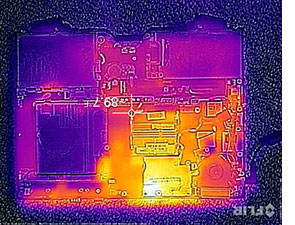 Overall, we're seeing a trend towards increased amounts of shielding and separation via plastic and metal foils. That's likely in part due to components sitting much closer in today's thinner and smaller devices, requiring protection against inadvertent touch, and in part due to extra shielding requirements for ever more numerous and more powerful onboard radio equipment. Overall, we're seeing a trend towards increased amounts of shielding and separation via plastic and metal foils. That's likely in part due to components sitting much closer in today's thinner and smaller devices, requiring protection against inadvertent touch, and in part due to extra shielding requirements for ever more numerous and more powerful onboard radio equipment.
Unlike in the S400 where an intricate copper thermal management system and a large fan dominated the visuals, you barely notice the tiny black fan inside the S410. It, too, uses copper piping to dispose of the heat generated by the processor and ancillary electronics via the fan and heat exchanger, but most is hidden beneath shielding.
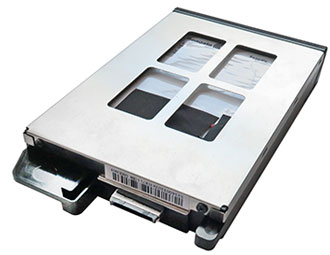 The reason for the much smaller fan is the S410's ultra-low voltage processor. Whereas the S400's thermal management had to be sized to handle the 37-watt thermal design power of its standard voltage "Haswell" Core i5-4210M processor, the S410's ultra-low voltage "Skylake" Core i7-6600U peaks at just 15 watts, so there's much less heat to remove (see infrared image above). The reason for the much smaller fan is the S410's ultra-low voltage processor. Whereas the S400's thermal management had to be sized to handle the 37-watt thermal design power of its standard voltage "Haswell" Core i5-4210M processor, the S410's ultra-low voltage "Skylake" Core i7-6600U peaks at just 15 watts, so there's much less heat to remove (see infrared image above).
Our evaluation unit came with a conventional rotating 500GB 2.5-inch hard disk from Seagate. The hard disk caddy (see image to the right) is nicely designed plastic box with a metal cover and different types of padding inside, more than enough to even keep an inherently more crash-prone rotating disk safe and sound. Solid State Disks are also available, and if the higher price of SSD isn't an issue, that's always our preference. There is a disk heater inside the caddy.
Also note the various colored wires that lead either to internal antennae, or to external antennae pass-throughs. Then there are the unit's three M.2 mini card slots. One half-size card slot is taken up by an Intel Dual Band Wireless-AC 8260NGW WiFi card, and there is also a full-size M.2 mini card, and an even longer one for use with an embedded secondary storage module. The latter could be used for the OS, making for quickest booting and software loading.
Much has changed on the battery front! Whereas the S400's battery was a massive 10.8 Volt/8,700mAH 94 watt-hour unit that weighed over a pound all by itself, the S410 has two smaller batteries, both with equal 46.6 watt-hour capacity. Battery 1, the main battery, is rectangular and weighs 9.4 ounces. The optional battery 2 is square, thinner, and weighs 10.4 ounces. 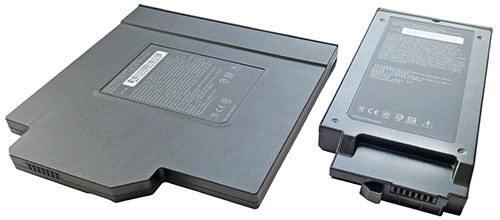
Why the change? Because the much more efficient ultra-low voltage processor can meet or beat the older S400's battery life with a powerpack half the size.
The smaller battery also allows a much thinner profile. And the slender bay for the optional second battery can also be used for an optional optical disk and other options such as PC Card and ExpressCard slots.
The dual batteries, of course, make them hot-swappable, a feature the S400 didn't have. And even that isn't all: the S410 can be ordered with a backup/bridge battery that packs a satisfying 7.2 Volt, 1,950mAH 14 watt-hours punch.
As a full-size semi-rugged notebook computer, the S410 comes with a large complement of ports, all of which are protected with hinged doors. Compared to the S400, the doors are of a new and improved design.
On the left side of the unit, starting on the left, are the garage for the 4.3-inch hard-tipped capacitive stylus with a lanyard loop, then the media/second battery bay and the mass storage caddy bay.
Along the back side of the S410 (shown below, protective doors removed) are, again from left to right, the fan vent, an HDMI port, two USB 3.0 ports, two gigabit RJ45 jacks, a VGA port and a native DB9 legacy serial port, and finally a Kensington-style lock slot.

On the right side (shown below, protective doors removed), from left to right, are the primary battery, a USB port, SIM card, audio in/out jack, SD card, smart card, another USB 3.0 port, and the power jack.

The protective doors are made of flexible black plastic and molded rubber seals. They are screwed onto the body of the S410, and can easily be replaced if needed.

The front of the unit does not have any connectors or ports other than the two speakers to the left and right of the unit. There wouldn't be room for anything else as most of the front is taken up the large, spring-loaded (it's not actually a spring, just a very clever design) handle that is an integral part of the system. The massive lineup of no fewer than eight indicator lights the older S400 had has given way to just two small lights, one for power status and one for battery.
Keyboard and hardware controls
A good keyboard is very important in a notebook for the field. If it isn't good, one might as well use a tablet. Getac's S4x0 series of semi-rugged notebooks has seen changes in its keyboard technology and layout over the several generations the platform has been available. Initially the S400 had older-style beveled keys. Getac then switched to a water-resistant mechanical membrane keyboard that used to be optional and looked a little busy. And now, the S410 has an improved 86-key keyboard that's more water-resistant yet.
The new island-style keyboard has been optimized for functionality, clarity and ease of use. Often-used keys — such as the space bar and the shift keys — are now wider. Thinner type and white-on-black icons make the keyboard look less busy and less cluttered. Main function labels are now on the upper left of a key so that adding a secondary function no longer results in off-center placement of the main function. The whole design looks and feels much like the standard Apple keyboard, which today is as much praise as "looks and feels like the IBM keyboard" used to be.
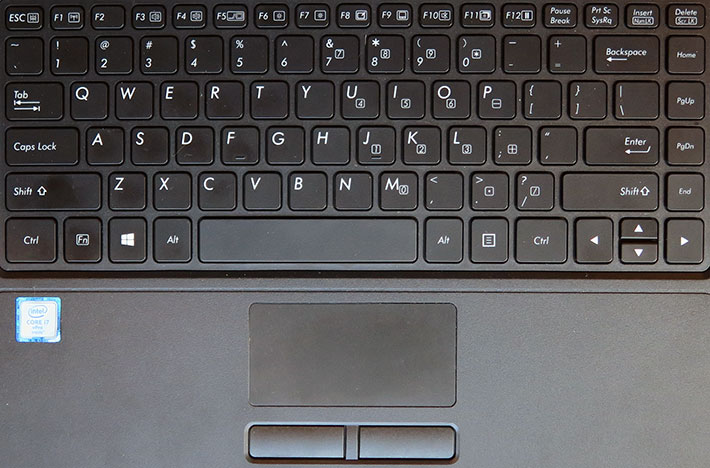
The touchpad and mouse button design has changed as well. It's simpler, too, and that's for the better. The two mouse keys are longer, which is a good thing, because the fingerprint reader that was between the two mouse buttons on the S400 has been moved to the right of the keyboard, where it belongs. The pad area is very slightly recessed. It uses capacitive multi-touch, works smoothly, but has a bit too much stiction for precise movement. What is "stiction"? It's defined as "the friction that tends to prevent stationary surfaces from being set in motion." The stationary surface, in this instance, is the finger, and it takes a bit of force to move it, rather than just glide away.
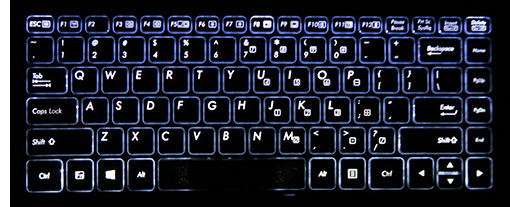 Our review S410 had the optional LED-based backlight that can be activated and toggled through three brightness settings via a function key combination. Illumination is now a blueish-looking white instead of red, and it pleasant and clearly illuminates the keys in semi and full darkness. Our review S410 had the optional LED-based backlight that can be activated and toggled through three brightness settings via a function key combination. Illumination is now a blueish-looking white instead of red, and it pleasant and clearly illuminates the keys in semi and full darkness.
One slightly distracting thing with this design remains that the illumination bleeds out around the keys in the dark. On the other hand, this also helps delineating the keyboard rather than having the labels just float in space.
 Above the keyboard are three hardware pushbuttons, two of them programmable for frequently used operations, and a clearly marked green power button. This is a substantial improvement over the button design on the S400, where it was easy to push the power button my mistake and the labeling wasn't very clear. Above the keyboard are three hardware pushbuttons, two of them programmable for frequently used operations, and a clearly marked green power button. This is a substantial improvement over the button design on the S400, where it was easy to push the power button my mistake and the labeling wasn't very clear.
On our machine, one of the function buttons brought up the G-Manager utility, the other toggled screen brightness from automatic to maximum. Having hardware buttons to turn quickly off the display and make it super-bright comes in very handy. It's much quicker than fumbling with menus.
Performance: state-of-the-art processor technology
One of the goals Getac set for itself with the S410 was to deliver best-in-class performance. That's actually not so easy as overall system performance depends on numerous factors, including processor, memory, mass storage, configuration, software and more. Everyone has access to the same Intel processors and other components, and so it becomes a matter of building a system that optimizes competing demands. That requires a good crystal ball and making some difficult decisions. For example, fast is always good and customers love it, but in notebooks fast generally also brings a bigger battery, more cooling, and that means higher weight and cost.
This is where good product planning comes in. That includes picking the right components and giving customers enough configuration choices to address both budget as well as features and performance issues, all without running into stocking logistics nightmares.
The S410 being a brand-new design, Getac had the advantage of using the newest generation of Intel processors. When it comes to processors, newer is always better, and having the latest chips under the hood is a definite competitive advantage. In this case, Getac had access to Intel's 6th generation of Core processors, codenamed "Skylake."
Are these generations important? They are. That's because a long time ago one of Intel's co-founders, Gordon Moore, stated that the number of transistors on a given surface area would double every 24 months. This became known as Moore's Law, and Intel has built its processor development strategy around it. In what Intel calls a 12-month "Tick-Tock" cycle, the company shrinks transistor size (so that more fit onto a chip) one year, and then takes advantage of the physics of the shrunken size to redesign the circuitry the next. In this system, Skylake is a "tock" processor redesign and optimization after the 5th generation "Broadwell" "tick" that shrank lithography.
|
Available S410 CPUs
|
Intel Core i7
|
Intel Core i7
|
Intel Core i5
|
Intel Core i5
|
Intel Core i3
|
|
Model
|
6600U
|
6500U
|
6300U
|
6200U
|
6100U
|
|
Cores/Threads
|
2/4
|
2/4
|
2/4
|
2/4
|
2/4
|
|
Base Clock Speed
|
2.60 GHz
|
2.50 GHz
|
2.40 GHz
|
2.30 GHz
|
2.30 GHz
|
|
Turbo Speed
|
3.40 GHz
|
3.10 GHz
|
3.00 GHz
|
2.80 GHz
|
No turbo
|
|
Thermal Design Power (TDP)
|
15 watts
|
15 watts
|
15 watts
|
15 watts
|
15 watts
|
|
Smart Cache
|
4MB
|
4MB
|
3MB
|
3MB
|
3MB
|
|
Integrated graphics
|
HD Graphics 520
|
HD Graphics 520
|
HD Graphics 520
|
HD Graphics 520
|
HD Graphics 520
|
|
Graphics base speed
|
300 MHz
|
300 MHz
|
300 MHz
|
300 MHz
|
300 MHz
|
|
Graphics max speed
|
1.05 GHz
|
1.05 GHz
|
1.00 GHz
|
1.00 GHz
|
1.00 GHz
|
|
Intel Stable Image Platform Program
|
Yes
|
No
|
No
|
No
|
No
|
|
Intel TSX-NI
|
Yes
|
No
|
Yes
|
No
|
No
|
|
Intel Trusted Execution
|
Yes
|
No
|
Yes
|
No
|
No
|
|
Intel vPro
|
Yes
|
No
|
Yes
|
No
|
No
|
So while being "current" in the use of Intel processors is fleeting, for now the S410 is indeed state-of-the-art under the hood. As always, Getac offers processor options from each of Intel's "good, better, best" approach with i3, i5, and i7 chips.
At the low end is the Core i3-6100U which doesn't have a "turbo" mode. Then there are the i5-6200U and i5-6300U, which differ a bit in speed and certain baked-in Intel technologies that may be irrelevant to most customers, but important to some. Finally, the top-of-the-line is the i7-6600U, which is the fastest of the lot, with the also available i7-6500U just a bit slower, but missing some possibly needed Intel technologies. Overall, these processors are not very different from one another, all having the same graphics, the same number of cores and threads, and mostly the same features. To see full spec table for these four CPUs, see here.
For a brief explanation of those Intel technologies: The extra security and manageability capabilities of vPro, especially, are required in many enterprise deployments (see Wiki Intel vPro). TSX-NI Transactional Synchronization Extensions New Instructions) helps make parallel operations more efficient via improved control of locks in software (see Wiki TSX), SIPP (Stable Image Platform Program) allows deployment of standardized, stable image PC platforms for at least 15 months (see Intel SIPP), and Trusted Execution technology provides security capabilities such as measured launch and protected execution, and may thus also be an enterprise requirement (see Wiki Trusted Execution Technology).
What is interesting here is that all available processors are of the "ultra-low voltage" variety, as compared to the "standard voltage" processors of the S400. All of them have a TDP (Thermal Design Power) of 15 watts, as opposed to 35 watts of the chips in the S400. 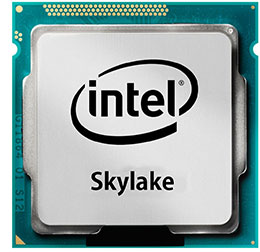 "Thermal Design Power" is an Intel standard that describes how much heat a system must be able to remove when using a certain processor. Obviously, the heat generated by 37 watts requires much more cooling than that by 15 watts. Back in the day, TDP was a good measure of performance as well, but today's CPUs can do more with less. "Thermal Design Power" is an Intel standard that describes how much heat a system must be able to remove when using a certain processor. Obviously, the heat generated by 37 watts requires much more cooling than that by 15 watts. Back in the day, TDP was a good measure of performance as well, but today's CPUs can do more with less.
See what that means? Getac switched to ultra-low voltage processors that use less energy, but thanks to their advanced technology provide the same or better performance than the older higher-wattage chips. Less energy means you don't need the same big battery, or you get longer life out of a charge if you keep the same battery. Getac banks on these new processors being so efficient that they provide the same or better performance than the older chips, which means the S410 has a much smaller battery, which helped designers make it thinner and lighter. It's like using am energy-efficient, high-tech 4-cylinder turbocharged motor instead of an old, low-tech V8 gas guzzler.
In order to get a sense of how the S410 performs compared to other Getac models and some competing products, we installed Passmark Software's PerformanceTest 6.1 that runs about 30 tests covering CPU, 2D graphics, 3D graphics, memory, and disk and then computes scores for each category and an overall PassMark score. We usually also run our second benchmark suite, CrystalMark. Unfortunately, due to some Windows 10 issues, several of the benchmarks did not run on our pre-production S410, and so we only have partial results. The results are below, and for comparison we added the original Getac S400 we tested in 2011, the updated S400 from 2014, the Getac V110 we tested in 2015, as well as the Dell 14 Rugged (which, despite its name, is semi-rugged), and the also semi-rugged Gammatech S15AB.
Below are the results:
|
Getac S410 Benchmarks and Comparisons
|
|
PERFORMANCE COMPARISON
|
Getac
|
Getac
|
Getac
|
Getac
|
Dell
|
GammaTech
|
|
Model (year tested)
|
S410
|
S400 (2014)
|
S400 (2011)
|
V110
|
14 Rugged Extreme
|
S15AB
|
|
Processor Type: Intel
|
Core i7
|
Core i5
|
Core i5
|
Core i5
|
Core i5
|
Core i5
|
|
Processor Model and Core gen
|
6600U (6th)
|
4210M (4th)
|
520M (1st)
|
5600U (5th)
|
4300U (4rd)
|
5200U (5rd)
|
|
CPU Speed
|
2.60GHz
|
2.60GHz
|
2.40GHz
|
2.60GHz
|
1.90GHz
|
2.20GHz
|
|
Turbo Speed
|
3.40GHz
|
3.20GHz
|
2.93GHz
|
3.00GHz
|
2.60GHz
|
2.70GHz
|
|
Thermal Design Power (TDP)
|
15 watts
|
37 watts
|
35 watts
|
15 watts
|
15 watts
|
15 watts
|
|
BatteryMon min draw
|
4.3 watts
|
9.5 watts
|
11.6 watts
|
4.4 watts
|
6.5 watts
|
5.4 watts
|
|
CPU Mark
|
4,841.7
|
4,181.8
|
2,184.6
|
4,084.8
|
3,522.0
|
3,536.7
|
|
2D Graphics Mark
|
525.5
|
602.9
|
248.3
|
527.3
|
474.7
|
518.4
|
|
Memory Mark
|
1,416.5
|
1,126.9
|
600.7
|
1,148.8
|
1,144.1
|
1,430.4
|
|
3D Graphics Mark
|
336.8
|
283.4
|
369.0
|
360.3
|
484.3
|
462.8
|
Even these partial benchmarks yield some interesting results. One of them is how very far the performance of Intel's Core processors has come since the initial generation back in 2010. Another is how how much more power-efficient the new processor generations are. Late-generation 15 watt chips can offer twice the performance of early-generation 35 watt processors. And the 6th generation 15 watt Skylake chips can easily provide the same or better CPU performance than 37 watt standard voltage 4th generation "Haswell" chips, like the one installed in our 2014 S400 tester. Finally, note that while integrated Intel graphics have come a very long way, discrete graphics chips can still do better in many graphics operations. Getac therefore offers optional NVIDIA GTX 950M graphics (which our tester didn't have).
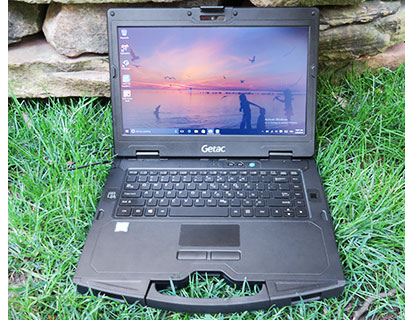 Also interesting is the power draws we observed in these machines. Power draw, of course depends on a large number of factors (display, backlight, power conservation hardware and software, and so on), but overall it's amazing how much more efficient systems using these new chips operate. That means less battery power is needed, which makes for thinner and lighter computers. Also interesting is the power draws we observed in these machines. Power draw, of course depends on a large number of factors (display, backlight, power conservation hardware and software, and so on), but overall it's amazing how much more efficient systems using these new chips operate. That means less battery power is needed, which makes for thinner and lighter computers.
One thing that's not shown in the table above is the great impact of the type of mass storage on overall performance. In short: conventional rotating hard disks are much slower than solid state media. Stripped systems almost always come with a standard hard disk, which is appealing because customers get more storage for less money, as SSDs remain significantly more expensive and SSD options often do not have enough storage capacity for a given task. But if you want all the performance your system is capable off, use solid state media.
The bottomline in the performance department is that the Skylake-powered S410 looks very attractive compared to the competition which is mostly still using 4th and 5th generation processors.
Power draw and battery life
What does the substantial performance mean for the S410's battery life? The competition has set the bar pretty high in this class, with Panasonic claiming 11 hours for a Toughbook 54 with a long-life battery and 18 hours with an optional second battery, and Dell 14 hours for their Latitude 14 Rugged with extended battery.
As is, the S410's standard 11.1 Volt, 4,200mAH Li-Ion packs a modest 46.6 watt-hours, which, however, is still more than the Panasonic Toughbook 54's 34.8 watt-hour "Lite" battery and the same as the 54's long life battery. Dell offers 65 or 97 watt-hour batteries for their Latitude 14 Rugged. The Getac S410 can accommodate a second 46.6 watt-hour battery for a total of 93.2 watt-hours, and Panasonic's secondary media bay battery packs 32.9 watt-hours for a total of 79.5 watt-hours. So it's obvious that we have a battery specs race going on here, in each case with "lowest weight" and "maximum battery life" options.
|
Getac S410 Power Draws (at idle)
|
|
Backlight level
|
Lowest
|
Room
|
Maximum
|
|
Power Saver
|
4.3 watts
|
6.7 watts
|
11.3 watts
|
|
Balanced
|
4.3 watts
|
6.8 watts
|
11.4 watts
|
|
Max Performance
|
4.3 watts
|
6.9 watts
|
11.4 watts
|
We tested power draw of the Getac S410 by running our standard BatteryMon benchmark. With Windows Power Options set to Power Saver and the display backlight set to its lowest setting, we saw a minimum of about 4.3 watts. That's theoretically good for 10.8 hours with one battery and 21.6 hours with both the standard and the secondary media bay battery.
With the backlight set to roughly 50% for comfortable indoor viewing, we saw a minimum of 6.7 watts, theoretically good for 7 hours with one battery and 14 hours with both. And with the backlight set to maximum brightness for outdoor viewing in bright sunlight, we saw a minimum of 11.3 watts, still theoretically good for 4.1 hours with one battery and 8.2 hours with both.
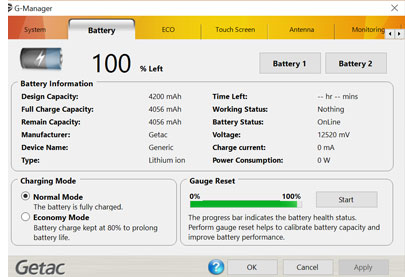 Interestingly, in the BatteryMon test, the standard Windows Power Options — Power Saver, Balanced, and Maximum Performance — all yielded about the same power draw. What that means is that even with the machine set to maximum power, it still idles along very economically. Under load, however, the battery draw under different Power options will be quite different. Interestingly, in the BatteryMon test, the standard Windows Power Options — Power Saver, Balanced, and Maximum Performance — all yielded about the same power draw. What that means is that even with the machine set to maximum power, it still idles along very economically. Under load, however, the battery draw under different Power options will be quite different.
Note that Getac's own G-Manager utility also includes a Battery status screen that pretty much confirmed the results we'd seen on BatteryMon. On a full battery, G-Manager showed a minimum draw that was around 4.3 watts, and suggested a run time of over 11 hours on a full battery. To the right is a screen capture of the very useful Getac G-Manager utility.
Real-world mileage will vary, as always. Minimum draw in a test lab is not an accurate predictor of actual battery life. Intel's Core processors have become very good at conserving power, to the extent where their "idle" draw is less than that of many Atom processors. Under full load, of course, the powerful Core chip will draw more than the limited Atom CPU.
Even so, between the excellent power management of Intel's Skylake processors, Windows' much improved power management, and the Getac S410's extensive power management settings, if need be, the S410 can run a very long time on a charge, especially with the second battery installed. Do keep in mind, though, that power settings do affect clock speed.
Bottomline here is that the new Skylake-powered S410 is significantly more energy efficient than the S400 we tested in 2014. With one battery installed — which means half of the S400's battery capacity — the S410 offers the same battery life of up to 11 hours, and that's without giving up performance. With both batteries, it runs twice as long as the S400 could.
Finally, customers can specify an internal bridge battery, which Getac says provides up to two minutes of power so the main battery can be changed. That 7.2 Volt, 1,950mAH bridge battery actually packs a full 14 watt-hours, which should be good for far more than two minutes, and more like up to three hours.
Bright 14-inch display with Lumibond 2 technology
The Getac S410's 14-inch display is large enough to allow working without squinting, and its 16:9 aspect ratio gives the computer a modern look (a lot of many older rugged laptops still use the squarish 4:3 aspect ratio). The standard display's 1366 x 768 pixel resolution is legacy by now, but just high enough for most work. 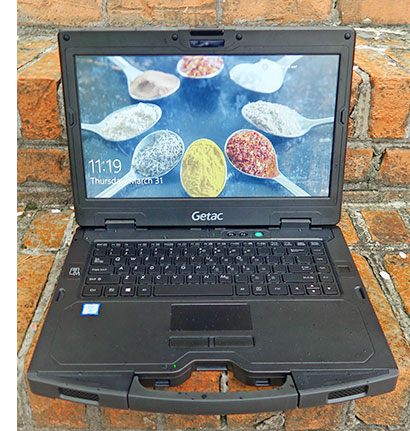 In terms of screen real estate, compared to the 1024 x 768 pixel XGA resolution that was the gold standard in rugged notebooks for many years, it's like getting getting an additional third added on the side. In terms of screen real estate, compared to the 1024 x 768 pixel XGA resolution that was the gold standard in rugged notebooks for many years, it's like getting getting an additional third added on the side.
That said, time has moved on, and with smartphones and consumer tablets now offering very high resolution, customers more and more expect the same form laptop screens. Our evaluation unit had the optional 1920 x 1080 pixel display, which makes for 157 pixels per inch. That's still not "retina" type of resolution, but it is a good deal sharper than the original iPad and Microsoft Surface. This would definitely be our preferred screen option for the S410.
Display size, though, isn't everything. Most rugged notebooks, including the S410, will be used outdoors and sometimes in bright, direct sunlight. Standard transmissive LCD displays, however, wash out in daylight, and that's why over the past few years, sunlight-readability has become a major selling point in the rugged notebook sector. The currently most popular way of making a notebook screen readable outdoors combines various optical treatments to control internal reflection with a strong backlight.
Rugged computer manufacturers have long been in a race for the best possible outdoor/sunlight-viewable display technology. Getac generally calls theirs "QuadraClear" (see QuadraClear page). The term derives from its four core features: a bright backlight, anti-reflective coatings, linear polarizer, and circular polarizer.
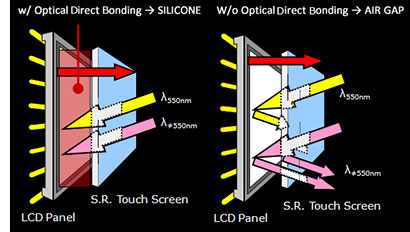 All major manufacturers of outdoor-usable mobile computing equipment use those technologies, and so the difference boils down to a) backlight brightness and b) the extent to which the expensive optical coatings are applied and how the various layers are bonded (the fewer reflective surfaces, the better). Getac calls their layer bonding process "LumiBond" (see LumiBond page). LumiBond 2 is Getac's capacitive multi-touch version of the technology, and also adds special modes for use in wetness, use with gloves on, and use with a pen. All major manufacturers of outdoor-usable mobile computing equipment use those technologies, and so the difference boils down to a) backlight brightness and b) the extent to which the expensive optical coatings are applied and how the various layers are bonded (the fewer reflective surfaces, the better). Getac calls their layer bonding process "LumiBond" (see LumiBond page). LumiBond 2 is Getac's capacitive multi-touch version of the technology, and also adds special modes for use in wetness, use with gloves on, and use with a pen.
A few words about screen brightness here: A standard notebook backlight is in the 200 nits luminance range (1 nit = 1 candela per square meter) range. Some manufacturers up the brightness in their rugged products, usually into the 300-400 nits range. Industrial monitors used outdoors generally have 400 to 500 nits. High end rugged notebooks offer anywhere from 500 to over 1,000 nits, with Getac offering as much as 1,400 nits in its B300 ultra-rugged. What this means is that the 800 nits backlight of the S410's 1920 x 1080 display is much brighter than any consumer notebook. And the 1,000 nits of the lower res 1,366 x 768 pixel standard display is brighter yet.
But aren't bright backlights bad for battery life? Yes, and that's why S410 users can easily toggle between "sunlight readable" on and off by pushing the P2 function button. Having that hardware button is the key to keeping power draw in check: when you need the extra-strong backlight, switch it on. When you don't need it anymore, turn it off. That's much easier with a button than via menus or function keys (both of which are also available in the S410).
How does it all work in real life? Quite well. The picture below shows a comparison between the S410 and a business-class Fujitsu Lifebook notebook we use around the lab.
The two machines are shown outdoors on a spring afternoon. The Lifebook is set to its maximum brightness, and it's actually a decent display with a matte finish that eliminates all harsh reflections. The more glossy S410 display does show reflections, but its big advantage is instantly obvious: the screen is super-bright.
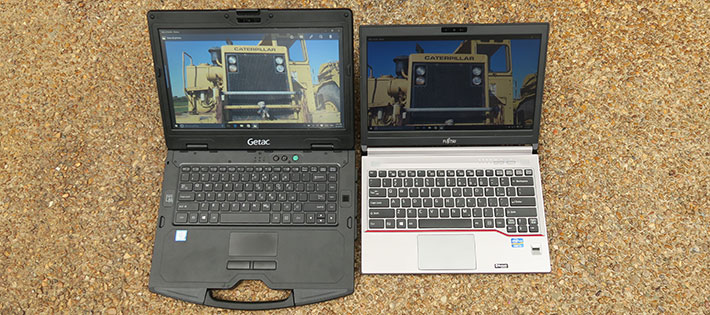
A few additional comments about the S410 display. While we described it as glossy above, semi-gloss would best describe it. Reflections on it are far more muted than those of most consumer laptops and tablets, almost all of which have high-gloss displays. And there's another quality the S410 display has: it's remarkably immune to the smudges and fingerprints that quickly mar almost all glossy displays. We criticized the S400 for being smudge-prone, so Getac must have fixed that in the S410.
The strong backlight can really save the day, but it must be used wisely as it draws a lot of power. There is currently much debate about backlight strength. Too little, and even the best screen quickly becomes unreadable outdoors. Too much and battery life will take a substantial hit.
Viewing angles are important. The horizontal viewing angle of the S410 screen is very good, without any color shifts even when viewed at extreme angles. The vertical viewing angle is also wide, but there are considerable color shifts as you change the angle. This used to be a common problem with TFTs, but there are now technologies that provide perfect viewing angles in all directions, and we hope Getac will consider this in the next generation of the platform or with a tech update.
Multi-touch and an very good narrow-tip capacitive stylus
Touch used to be an uncommon option on notebook computers, but tablets and the latest versions of Windows (8.x, 10) have changed all that. Touch is now considered part of the computing experience, and it's almost mandatory with Windows 10. And, of course, not just any touch, but capacitive multi-touch. That's pretty much the default these days, and has been ever since the first iPhone introduced all that elegant, effortless tapping, panning, pinching and zooming to the world.
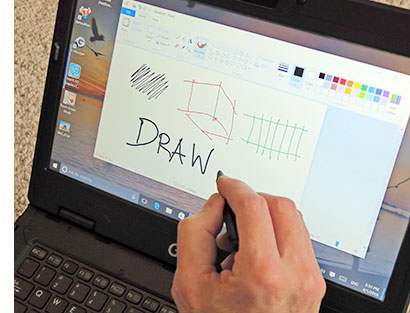 That said, while capacitive multi-touch works great on tablets and all those iOS and Android apps specifically developed for handhelds and tablets, Microsoft Windows was not developed for touch and it can be a bear to use Windows with touch, especially when using the legacy desktop and legacy Windows software with all those tiny check boxes, screen borders and scrollers. Windows 10 is more touch-optimized, but it'll likely take a few more changes to Windows before it's truly touch-optimized. And whether reaching over a full-scale keyboard to touch a display will ever become truly natural is anyone's guess. That said, while capacitive multi-touch works great on tablets and all those iOS and Android apps specifically developed for handhelds and tablets, Microsoft Windows was not developed for touch and it can be a bear to use Windows with touch, especially when using the legacy desktop and legacy Windows software with all those tiny check boxes, screen borders and scrollers. Windows 10 is more touch-optimized, but it'll likely take a few more changes to Windows before it's truly touch-optimized. And whether reaching over a full-scale keyboard to touch a display will ever become truly natural is anyone's guess.
How did Getac address this tough predicament in the S410? By offering both remarkably smooth and responsive capacitive multi-touch, and a very good capacitive stylus. No word as of yet whether there will be an active digitizer/pen option which would likely be welcomed by Windows 7 customers with heavy use of legacy apps.
A word about the capacitive stylus. Capacitive styli have been around almost as long as capacitive multi-touch tablets, but most have broad rubber or mesh tips that make them all but useless for anything but tapping on the screen. The stylus that comes with the S410 has a hard and much narrower 3.5mm tip. That's roughly the size of a Sharpie permanent marker tip. The tip is spring-loaded, though it doesn't appear to have pressure-sensitive functionality. The picture below shows the new stylus that comes standard with the S410. It is 4.75 inches long and neatly stows away in a garage on the left side of the laptop.

While the narrow-tipped S410 stylus is much better than those old broad ones, don't expect the precise and smoothly flowing ink possible with an active Wacom-style digitizer. But it's much better for drawing or handwriting recognition than any resistive stylus.
Works with gloves and when it's wet
Another issue with capacitive touch is that it in its generic form, it only works with human fingers or, to a lesser extent, with capacitive styli. Standard capacitive touch doesn't like rain and it won't accept gloves. Unfortunately, wetness and the need for gloves is exactly what one often encounters where ruggedized computing gear such as the Getac S410 is used.
Getac knows that and already addressed the issue in the 2nd generation V110 and F110 released earlier in 2015, and also the RX10 tablet released later in 2015. All of those use Getac's Lumibond 2.0 technology which offers capacitive multi-touch and glove capability (the original Lumibond used resistive multi-touch).
So just like the aforementioned Getac devices, the S410 has a G-Manager "Touch" tab where users can select "Touch," "Glove," or "Pen."
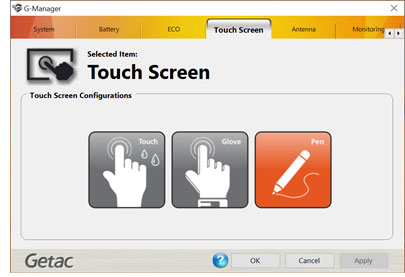 "Touch" — Drops near the hand on the "Touch" icon suggest that touch continues to work "with direct exposure to rain." That is something regular capacitive displays struggle with. Water is so conductive that it affects the capacitance between two electrodes, which is the concept upon which projected capacitive touch is built. "Touch" — Drops near the hand on the "Touch" icon suggest that touch continues to work "with direct exposure to rain." That is something regular capacitive displays struggle with. Water is so conductive that it affects the capacitance between two electrodes, which is the concept upon which projected capacitive touch is built.
What can be done is switching from a standard mutual capacitance mode to self-capacitance where the capacitance between one electrode and the ground is measured instead of the capacitance between two electrodes. The S410's passive pen does not work in this mode, which would point toward a self-capacitance solution (unlike in the Getac V110 where the passive pen continues to work in wet mode), but Getac says they used controller sensitivity to handle the job.
"Glove" allows the S410 to be operated with gloves. That is usually done by increasing the sensitivity of the touch controller, so that it can recognize a finger even a brief distance away from the screen, as in the distance that the material of a glove adds to the finger's distance from the screen. That's the way Getac seems to have done it, as not only do gloves work in this mode, but the cursor now follows the finger even when it is a short distance away from the surface, and touch operations no longer require a firm touch.
"Pen" makes the screen only work with the capacitive pen, and not with either bare or gloved fingers.
Wireless and expansion
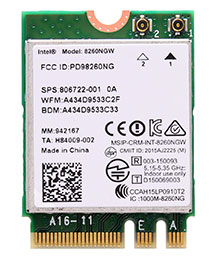 The Getac S410 comes with an Intel Dual Band Wireless-AC 8260 that provides 802.11ac WiFi and dual-mode Bluetooth Version 4.2. 802.11ac is three times faster than 802.11n. And Bluetooth 4.2 can offer significantly faster data transfer due to longer packet size, is more secure, and allows interfacing with the latest low-energy Blue Tooth devices. The Getac S410 comes with an Intel Dual Band Wireless-AC 8260 that provides 802.11ac WiFi and dual-mode Bluetooth Version 4.2. 802.11ac is three times faster than 802.11n. And Bluetooth 4.2 can offer significantly faster data transfer due to longer packet size, is more secure, and allows interfacing with the latest low-energy Blue Tooth devices.
An integrated dedicated GPS receiver is optionally available, and for Wide Area Network communication, there is an optional Gobi mobile broadband module with carrier independence.
As far as expansion and customization go, the S410 offers far more possibilities than the older S400 via optional I/O ports, rotating and solid state media, secondary solid state storage, battery options, display resolution options, security options, communications and antenna options, and an unusually wide variety of accessories.
Add to that the S410's media bay that can accommodate either an optical drive, the second battery, a legacy PC Card Type II slot, or an ExpressCard34/54 slot. With the older S400, while the unit's optical drive was removable, it could not be used for other options.
Security
Like most mobile hardware these days, the S410 offers various levels of hardware and software security to prevent unauthorized access as well as theft. That includes multifactor authentication via passwords, fingerprint reader, smartcard reader and/or optional contactless Smartcard.
Our system included Intel Trusted Platform Module (TPM) 2.0 hardware security for enhanced boot process integrity, and to create and manage computer-generated digital certificates. Combined with the Windows Hello software in Windows 10, it can encrypt biometric data. In addition, TPM can be used to create certificates that can be used to:
- Send and receive secure email,
- Set up the browser for client identification,
- Sign Word macros,
- Encrypt individual files or entire folders, and
- Create secure network connections.
Fingerprint registration software works with the S410's fingerprint scanner that now uses capacitive technology so users can just place their finger on the scanner rather than swiping.
All of this can get pretty involved. Some users may never implement TPM, fingerprint scanning or even passwords, whereas others may be set up in accordance with their company's IT security procedures, or they may configure an individual system for maximum security.
Over all this, don't forget physical security and get a Kensington locking cable to use with the Kensington slot on the backside of the unit. It is inexpensive insurance against theft.
Additionally, depending on the processor, S410s can be configured with Intel vPro, a set of technologies to remotely access and control computers securely. And Absolute DDS (stands for Device & Data Security, formerly known as CompuTrace) is also optionally available. The way that works is that there's a constant two-way between device so that risk can be monitored and assessed remotely, and the device disabled if need be.
Docking and vehicle mounting
Semi-rugged notebooks such as the Getac S410 are often used in vehicles. To that extent, Both Gamber-Johnson and Havis are offering vehicle docks for the S410. These can be mounted in numerous ways, using the dock manufacturers' solutions or the vast variety of RAM ball and joint components.
The S410 has separate antenna pass-throughs for GPS, WLAN and WWAN. These are supported by the vehicle docks, which makes roof-mount antennae possible. A set of pogo docking pins on the bottom of the S410 allow the docks to provide port duplication and additional I/O functionality.
Getac G-Panel
The S410 comes with the Getac G-Panel that combines a number of special utilities and helper apps that make using the unit quicker and simpler than going to the standard Windows control panels, which can be a cumbersome process.
- System provides a one-look summary of all major data, including battery status, CPU load and clock speed, wireless LAN signal strength, free RAM and so on. You can also drill down for more detailed and technical data.
- Battery shows % left in a large numeral, plus just about any other battery statistic you may want. It also shows the current power consumption. With the backlight at its 800 nits maximum, the reading was almost 12 watts, with the backlight at minimum and ECO mode engaged, that dropped to 9 watts or so.
- ECO displays and controls power savings settings. You can customize the settings and even have certain features such as Bluetooth, WiFi or the touch screen turned off.
- Antenna lets S410 users manage antenna settings for the optional GPS module.
- Monitoring lets you graphically view about a dozen parameters such as CPU clock, load, voltage, temperature; free RAM, LAN stats, etc. They pop up in their own windows, and the only additional wish I'd have is being able to set the graph upper and lower limits.
- GPS Status shows satellites and summary GPS data.
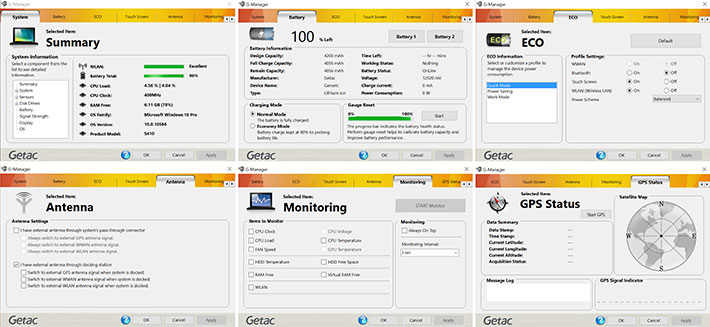
Ruggedness
The Getac S410 is a semi-rugged computer that Getac says was designed "to meet or exceed MIL-STD-810G temperature, shock, humidity, altitude and vibration specifications." Getac also claims a 3-foot drop. That's generally enough to let a unit survive a fall from a desk. Here, the S410's corner rubber bumpers certainly help, as does the integrated rubber handle.
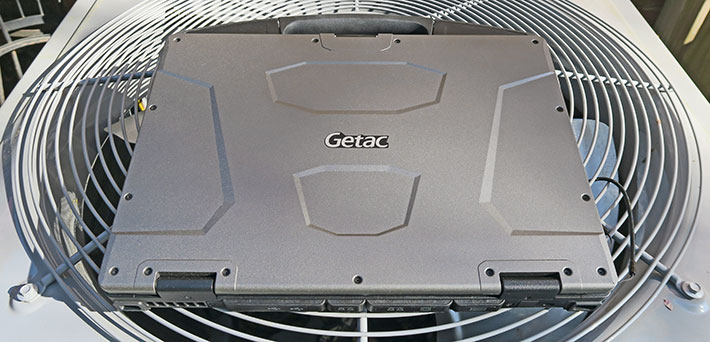
As for more specific environmental specs, the S410 has an operating temperature range of -6 to 140 degrees Fahrenheit, making it suitable for use in almost any environment. The wide range comes in handy in several targeted depplyments, such as closed vehicles or around freezers.
As far as sealing goes, the S410 carries an IP51 rating, where the "5" means that the unit is protected against dust (but with limited amounts permitted) and that it's also protected against vertically falling drops of water. That's a slight upgrade from the S400 whose IP5x rating meant there was no ingress protection against liquids at all. So just to be clear on this: Since the S410 has vents on its bottom, it is not a waterproof design and its bottomside should not get in contact with water. 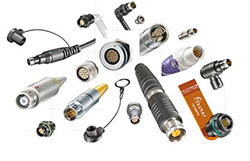 On the other hand, Getac designed the S410 to handle common occurrences such as spills onto the keyboard and keypad, and all ports now have protective covers. On the other hand, Getac designed the S410 to handle common occurrences such as spills onto the keyboard and keypad, and all ports now have protective covers.
Note that Getac offers optional rugged I/O connectors for customers who need them. The S410 can be ordered with Fischer Connectors' rugged 5-pin USB 2.0 and rugged 9-pin LAN ports.
Getac's S410 specs state that the unit is "MIL-STD-810G certified" and drop and vibration resistant. That alone doesn't say much, but Getac undoubtedly can produce more detailed test documents so that prospective customers can see what, exactly, the unit can handle and what it cannot. What became clear in our testing, though, is that the S410 feels very sturdy and very trust-inspiring. While its looks probably suggest it is even tougher than it is, this machine seems plenty capable of handling the likely abuse encountered in its intended deployments.
Bottom line: Getac S410
The semi-rugged Getac S410 notebook computer, introduced in April 2016, is not just a tech update to the company's long-running S400. It is an entirely new design conceived to be thinner, lighter and more configurable than its predecessor (which will remain available for a while). In fact, about the only thing that remains the same is the 14-inch size of its display.
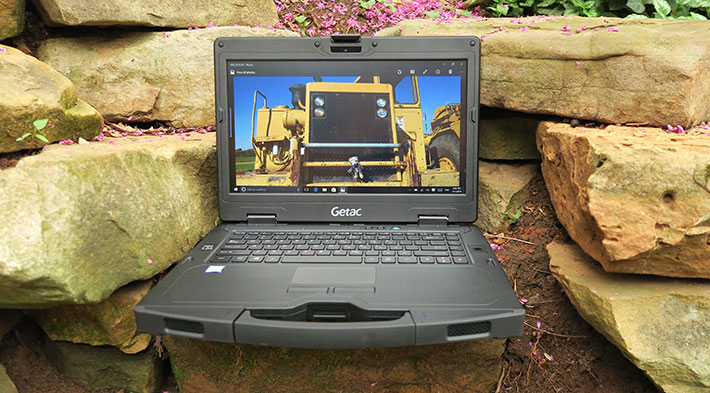
The S410 has shed more than a quarter of its predecessor's thickness and close to a quarter of its weight, making for an entirely more contemporary computer for field mobile or vehicular deployments in public safety, armed forces, government, field service, manufacturing and professional services. This was made possible by switching from 4th generation "Haswell" processors in the S400 to 6th generation "Skylake" CPUs in the S410. The move allowed the use of ultra-low voltage instead of standard voltage chips without giving up any performance and getting the same battery life from a much smaller battery.
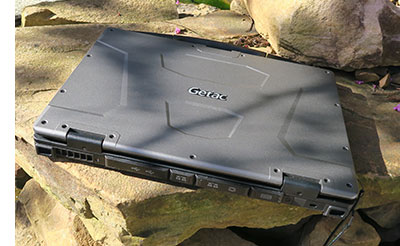 Visually, the S410 sports a tougher and more rugged appearance that clearly sets it apart from consumer laptops. Both the standard 1366 x 768 and the optional high-res 1920 x 1080 displays are very bright and have smoothly operating capacitive multi-touch that can be set via control panel to work with gloves, with a supplied capacitive narrow-tip pen, and in wetness. Visually, the S410 sports a tougher and more rugged appearance that clearly sets it apart from consumer laptops. Both the standard 1366 x 768 and the optional high-res 1920 x 1080 displays are very bright and have smoothly operating capacitive multi-touch that can be set via control panel to work with gloves, with a supplied capacitive narrow-tip pen, and in wetness.
The S410 is available with several Skylake processor options. Our test unit, equipped with the top-of-the-line 2.6GHz Core i7-6600U processor turned in excellent benchmark performance. For maximum graphics performance, an NVIDIA discrete GPU is offered. Despite its high performance, the S410 offers very good battery life with one battery, and exceptional (up to 20+ hours) battery life with two. Between rich onboard I/O, optional port configurations, and a multi-purpose media bay, there's little the S410 can't do.
"Semi-rugged" design here essentially means the ability to survive a reasonable degree of shocks, vibration, spills, etc., without incurring the extra cost and weight of full ruggedness. The S410, however, is not a sealed device.
Overall, the semi-rugged Getac S410 laptop computer, which starts at a very reasonable US$1,399, skillfully balances very good performance, long battery life, vastly customizable connectivity, and sufficient ruggedness for many tasks into a very attractive package that should match up very well with the competition.. -- Conrad H. Blickenstorfer, April 2016
|
Getac S410 semi-rugged notebook Specifications
|
| Type |
Semi-rugged notebook
|
| Introduced |
Introduced April 2016
|
| Processor |
Intel Core i7-6600U, 2.6/3.4 GHz, 4MB Intel Smart Cache
Intel Core i7-6500U, 2.5/3.1 GHz, 4MB Intel Smart Cache
Intel Core i5-6300U, 2.4/3.0 GHz, 3MB Intel Smart Cache cache
Intel Core i5-6200U, 2.3/2.8 GHz, 3MB Intel Smart Cache cache
Intel Core i3-6100U, 2.3GHz, no turbo, 3MB Intel Smart Cache cache
|
| Thermal Design Power |
15 watts (all)
|
| Graphics |
Integrated Intel HD Graphics 520, optional NVIDIA GTX 950M discrete GPU
|
| OS |
Windows 10 Pro, Windows 7 Professional
|
| Memory |
4GB DDR3L, expandable to 16GB in two SODIMM slots |
| Display |
14.0-inch/1366 x 768 pixel Lumibond TFT with semi-matte surface, sunlight-readable (1,000 nits); 14.0-inch/1920 x 1080 pixel Lumibond TFT with semi-matte surface, sunlight-readable (800 nits) |
| Digitizer |
Capacitive multi-touch technology (with both display options) |
| Keyboard |
86-key full-scale water-resistant membrane keyboard; optional water-resistant LED backlit membrane keyboard
|
| Storage |
SATA HDD 500GB; optional SATA HDD 1TB; optional SATA SSD 128GB / 256GB / 512GB; optional 2nd storage (onboard): 128GB SSD
|
| Expansion slots |
1 x Smart Card, 1 x SD card reader
|
| Media Bay |
Optional PCMCIA Type II, ExpressCard34/54, DVD super multi drive, 2nd battery
|
| Housing |
Getac "KryptoShell" ABS+PC material |
| Size |
13.8 x 11.5 x 1.4 inches (350 x 293 x 35 mm)
|
| Weight |
5.9 lbs. as tested, with one battery
|
| Operating temperature |
-6° to 140° Fahrenheit (-21° to 60° C) |
| Ingress protection |
IP51, splash-resistant keyboard
|
| Drop |
3-foot drop
|
| Humidity |
95% RH, non-condensing
|
| Other environmental |
Vibration resistant
|
| Power |
Battery 1: Li-Ion (11.1V, 4,200mAh, 46.6 watt-hours), optional Battery 2 (11.1V, 4,200mAh, 46.6 watt-hours), optional bridge battery (7.2 Volt, 1,950mAH 14 watt-hours) |
| Security |
Optional: Intel vPro, TPM 2.0, fingerprint scanner, smart card reader, contactless Smartcard reader, Kensington lock
|
| Camera |
Optional: 1 x FHD user-facing camera
|
| Interface |
3 x USB 3.0, 1 x USB 2.0, 1 x HDMI, 1 x RJ45 gigabit LAN, 1 x docking, audio in/out, power; optional: 1 x RS232, 1 x VGA, RF antenna pass-through for GPS/WWAN/WLAN, 2nd RJ45 OR rugged RJ45 OR rugged USB 2.0 OR powershare USB 2.0
|
| Wireless |
Intel dual-band Wireless-AC 8260 (802.11ac WiFi, Bluetooth V4.2), optional: dedicated GPS, 4G Gobi mobile broadband
|
| Price |
Starting at US$1,349 |
| Contact |
GETAC us.getac.com |
| Contact |
S410 spec sheet (PDF) |
| Warranty |
3 years limited
|
|
Contact
|
GetacSales_US@getac.com
us.getac.com
949.681.2900
Getac, Inc.
15395 Sand Canyon Ave., Suite 350
Irvine, CA 92618
|
(copyright 2016 RuggedPCReview.com)
|
|












